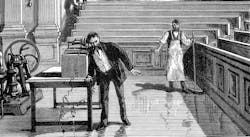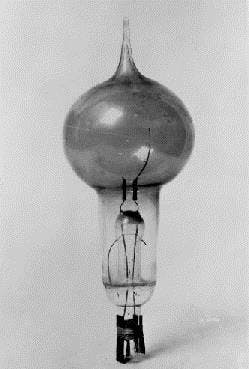The cyber security issues faced by the utility industry and other industries should come as no surprise, given how the Internet got off to a bad start, as inventions go. In fact, compared to the electric utility industry and the development of the telecommunications industry, the Internet’s early history was quite undignified, and its initial progress was relatively slow.
Early history of the telephone: On March 10, 1876, Alexander Graham Bell shouted into his telephone’s mouthpiece:
“Mr. Watson, come here — I want to see you.”
Bell reported, to his delight, that his assistant Thomas A. Watson “came and declared that he had heard and understood what I said.”
The first commercial telephone services were set up on both sides of the Atlantic in 1878 and 1879, in New Haven, Connecticut, and London, England. By the mid-1880s inter-city lines and telephone exchanges were built in every major U.S. city.
In the early 1880s the first electric companies started operating central power stations in New York and London, and by 1890 there were 1,000 central stations in operation.
Early history of the Internet: The World Wide Web (abbreviated WWW) was invented in 1989 and the first website (see "The First Web Site below") was created shortly thereafter.
Then, on April 30, 1993, CERN published a statement that made World Wide Web technology available on a royalty free basis, allowing the web to flourish.
It was 23 years earlier that the start of the Internet occurred.
On October 29, 1969, the following exchange occurred between personnel at Defense Advanced Research Projects Agency (DARPA) locations in LA and Menlo Park:
We typed the L and we asked on the phone:
"Do you see the L?"
"Yes, we see the L," came the response.
We typed the O, and we asked,
"Do you see the O?”
"Yes, we see the O."
Then we typed the G, and the system crashed...*
*The October 29, 1969 DARPA history is from the book "Roads and Crossroads of Internet History" by Gregory Gromov.
The First Web Site
The WorldWideWeb (W3) is a wide-area hypermedia information retrieval initiative aiming to give universal access to a large universe of documents.
Everything there is online about W3 is linked directly or indirectly to this document, including an executive summary of the project, Mailing lists , Policy , November's W3 news , Frequently Asked Questions .
What's out there? Pointers to the world's online information, subjects , W3 servers, etc.
Help on the browser you are using
Software Products A list of W3 project components and their current state. (e.g. Line Mode ,X11 Viola , NeXTStep , Servers , Tools , Mail robot , Library )
Technical Details of protocols, formats, program internals etc
Bibliography Paper documentation on W3 and references.
People A list of some people involved in the project.
History A summary of the history of the project.
How can I help ? If you would like to support the web..
Getting code Getting the code by anonymous FTP , etc.
Save
Save
Save
About the Author
Peter Arvan Manos
Utility Industry Analyst
Peter Manos is Director of Research for Electric Power & Smart Grid, on the Energy Sector team at ARC. He analyzes the latest trends across People, Process, and Technology to uncover business and digital transformation best practices for electric, gas, and water utilities. He can be reached at [email protected]

